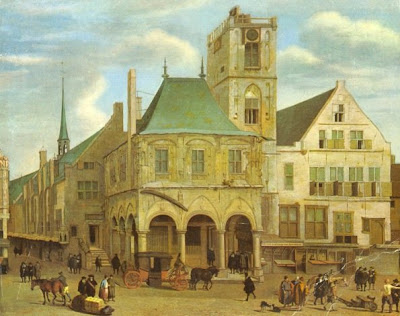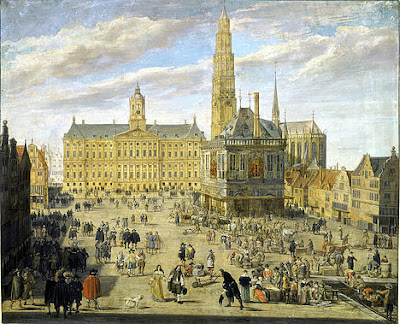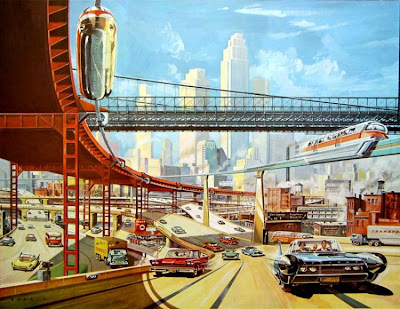
Not (yet) built: a vision of the future
It would be fascinating to compile a collection of images of the future as they have been created by people throughout the ages. What is the earliest (remaining) expression of ‘future’ that could be at the heart of such a collection?
In some respects the Egyptian pyramids are a reflection of a people’s futurism: for they were built to cater for the afterlife – which essentially is a kind of future for the deceased.
But even though the afterlife may be the eternal future for all of us, I was rather thinking of our fantasies of an imagined, future living world. It would be interesting to establish when exactly mankind started to produce them with the explicit intention of picturing a time beyond their own. In words or in paintings, sculptures – and other architecture than pyramids.
Perhaps architecture indeed is the profession which first took hold of the future in substantive images. Architects were the first great designers and planners. They had to see far ahead. Their whole existence was driven by their vision of some future.


An example of a jump into the future
The old and the new City Hall (now royal Palace) of Amsterdam, 17th century
(Depicting a tower on the New Church that was never built)
But if we focus at the phenomenon of the future, for instance as it is frequently envisaged in our contemporary science fiction: is this kind of fascination with future a pure product of our own time and culture and was, for instance, Jules Verne the first real pioneer in the respect?
Moviemaking and futurism perhaps have been part and parcel of each other from the moment of the conception of the cinema. One of the first real movies was about sending a rocket to the moon, and arriving there. Jules Verne had been its story’s originator.
So, the issue is: what is the history of futurism (not: futurology!) and how can this history best be demonstrated?
It may be true, as some literature on this subject contends (see sources below), that substantive futurist inspiration came with the Age of Enlightenment and Industrialization. This development must indeed have pushed the fantasies of the human mind a giant leap further. Suddenly the world seemed much more ‘engineer-able’. One can readily see that. And again, designers and builders most likely were the most powerful driving forces behind the development of futurist imagery. Perhaps even more for what was not built – at the time – than for the buildings and constructions that ultimately were accepted or approved. This idea is not new. Not long ago a book was published in the Netherlands, called “Never built in Holland”, containing an extensive catalogue of concepts and designs for public buildings which never left the drawing table. Most of these designs, even by hindsight, seem far out of step with the architecture of their own time, many of them being either a gross exaggeration of contemporary styles and fashion, or too visionary. But this, in many ways, is the essence of any ‘futurism’.

Futurism of the nineteen fifties: contemporary trends exaggerated

Futurist painting
This painting of the "Dynamism of a Cyclist" 1913 by Umberto Boccionidemonstrates the Futurist interest in film. Borrowing from Cubism, the Futurists were interested in the dynamics of speed and the simultaneity of the image in motion. Boccioni also created sculptures, which attempted to free the object from its traditional status, creating instead, a fluid medium infused by technology and raw energy.
In another way the subject is about the development and history of human imagination. Its focus over time, from the heavenly to the hellish. From inner space to outer space. Eventually it reached the whole concept of space and time itself. Einstein became the godfather of futurism when science and fiction merged. Without Einstein we would not have created StarTrek in much the same way. Without Einstein we wouldn’t have been fiddling with all the contradictions he revealed about space and time and the (im)possibilities to play with them.
And – one could say: as a kind of (gruesome) intermission between Einstein and our modern world - futurism could also be nourished as a great jump back in the past: witness of this fascination are the designs of Albert Speer for Hitler’s new Berlin, reminiscent of ancient Rome.

Albert Speer’s futurist Berlin of the nineteen thirties
This period was followed by the marriage between moviemaking and space travel. The Apollo 11 mission to the Moon drew many of its concepts from Kubrick’s 2001 A Space Odyssey.
In our recent time the greatest marriage is between moviemaking and the pioneers of the information age. No doubt, hundred years hence, our representations of ‘the future’ again will be unmasked as mere exaggerations of trends and fashions already in existence in our own time.

Futurism in the movies
(Minority Report)
I am member of a generation for which ‘change’ and ‘progressiveness’ have been the key obsessions. Our entire sense of progressiveness depends on an active imagination of an unknowable future. We cannot accept stagnation in any dimension. The future holds the sum total of all our current dreams. When we grew up ‘the year 2000’ was magic. It seemed far away and in our minds it was filled with the outmost modernity. And when this magic year came, on the early morning of January 1st, the most remarkable feature of ‘2000’ was that in fact so much had not changed. We didn’t fly in private helicopters, we didn’t transport ourselves to other planets in a whiz, and yes, there were many more huge skyscrapers and large scale traffic networks than – say – thirty or forty years before, but large segments of our countryside had remained unaffected. One could still look at cows grazing in a meadow and at cyclists waiting for a red traffic light.
Indeed, the greatest challenge for any futurist image is its depiction of continuity, of things unchanged. Mankind has already proven its power of imagination and innovation far in excess of immediate possibilities. The idea of ‘future’ inspires gifted visionaries to come with bold breakthroughs for instance in construction, consumer appliances or culture where the average human being would stop at slight improvements only. But to think of aspects, material or otherwise, of our environment and life styles that will not substantially change may well require a similar imaginative talent. In a way, this is exactly what we wish to express when we declare our monuments. It is unthinkable that humanity would ever deliberately tear down the pyramids or destruct the paintings of Rembrandt. In any credible depiction of the future they should be a fixed element.
Futurism is not about senseless dreaming. Mankind is making a progressively larger and more lasting impact over a longer period. Depicting these implications in far reaching futurist images or concepts can be seen as a serious effort to visualize – and integrate – them in a comprehensive concept of the future. One could see this as a ‘scientific’ process but I would consider it not less an artistic one. In this effort we can learn from the futurist images and concepts of the past. Its exhibition therefore would not only serve our curiosity for its own sake. It would equally help us guiding our actions between the fixed and the flexible in every dimension of the heritage we will finally leave behind.
SOURCES
Idea about the future : a history of futurism, 1794-1982.
by Burnham P. Beckwith
Women Artists of Italian Futurism: Almost Lost to History. - Review -
book reviewsArt Journal, Fall, 1998 by Deborah Johnson
http://www.lib.udel.edu/ud/spec/findaids/futurism.htm
The Futurism Collection , University of Delaware 1909 - 1969
Revelation, Futurism, and Dispensationalism
By Glenn Weiser
http://www.celticguitarmusic.com/Endtimes.htm

